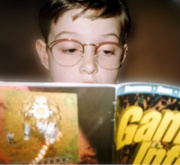Current research is looking into whether reading triggers myopia in children who have a genetic propensity for it. Myopia is a vision condition that results in difficulty seeing objects at a distance but near objects can be seen clearly. Myopia occurs because the eyeball is too long or the focusing power is too strong. Thus light focuses in front of the retina instead of directly on it causing blurred distant objects.
In some areas of the world as in Singapore and Taiwan approximately 80 percent of 17- and 18-year olds require eyewear for myopia (nearsightedness). This large percentage is a relatively new development - only 30 years ago it was 25 percent. This trend is also being seen in the western hemisphere with children needing glasses at younger and younger ages. So what's happening with the world's children? Eyecare science and technology have made great strides in managing myopia but there is a virtual standstill when it comes to preventing its onset or halting its progression. This is because eye researchers still remain uncertain about the causes of myopia.
It is obvious that genetics plays the predominant role in the development of nearsightedness. If both parents have significant myopia it is very likely that their children will develop myopia as well. But what causes the discrepancy between different geographical locations? It can only be concluded that refractive error is determined by both genetic and environmental factors. There s evidence that one major environmental contributor is the amount of close-up work. Research indicates that increasing rates of formal education and literacy have resulted in increasing rates of myopia. Children today do a lot of reading, computer work and near tasks (eg. video games). Each of these activities involves close-up vision. One hypothesis is that the eye adapts to the amount of near work performed (especially during the developmental years) and subsequently elongates and becomes myopic. Current research is looking into whether reading triggers myopia in children who have a genetic propensity for it. Once the exact mechanism is determined pharmaceutical treatments could be developed that could halt or slow the elongation of the eye and subsequently reduce myopia.



